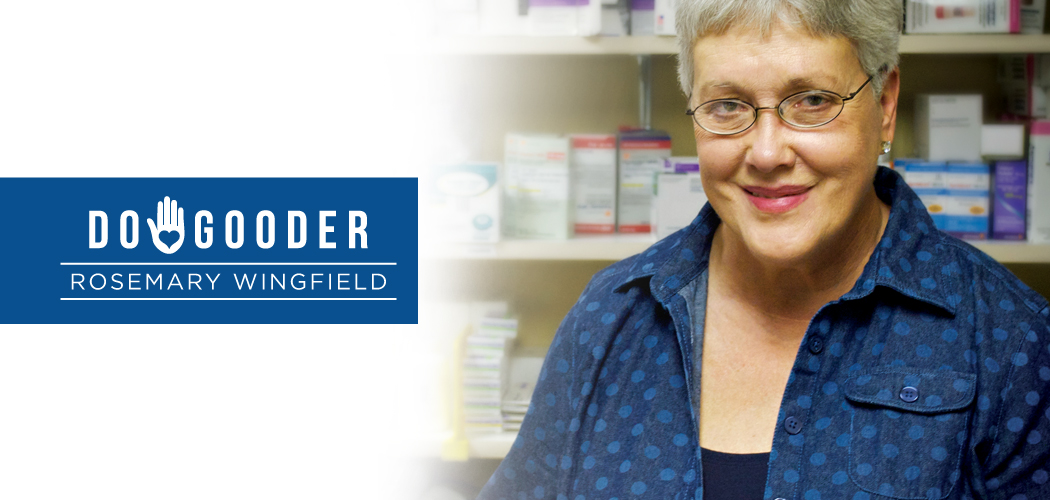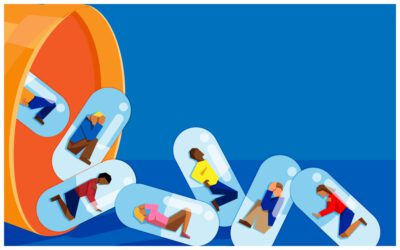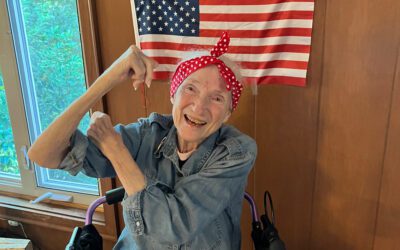[title subtitle=”words: Marla Cantrell
Image: Jeromy Price”][/title]
Rosemary was nominated as a Do South Do-Gooder by her sister, Lucy Fry.
Rosemary Wingfield, at age seventy-one, says one of her most prized possessions is a cigarette case that had a marijuana leaf on its cover.
The case was given to her in a sack with about fifty ball point pens by a man named Roger, who was then a patient at the Good Samaritan Clinic in Fort Smith, Arkansas, where she volunteers. Rosemary believes he found it inside a dumpster, the place he often looked for discarded treasures.
Rosemary thanked Roger, and when she got home she showed her husband, who smiled, shook his head, and then told his MasterGardener wife her newest possession was just the slightest bit illegal.
As she’s telling the story, she glances out the window and her eyes grow a little misty. She talks about the day she met Roger, not long after the clinic opened. He had just been released from the hospital, had no family, almost no money, and he needed care.
Good Samaritan Clinic is a faith-based ministry that provides affordable health care for our most vulnerable neighbors. Roger certainly qualified. When Rosemary tried to determine his income so she could complete his paperwork, he told her he brought in $20 a week selling aluminum cans. She remembers how proud he was of the money, how it served as the buffer that kept him from feeling destitute, but was far too little to put a roof over his head.
One of the first things she did was mention she had aluminum cans she needed to get rid of. And then she said her sister, Lucy Fry, who also volunteers at the clinic, was in the same position. Before long, a routine began. Each Tuesday, Roger would come to the door and collect their stash of cans.
And then, one Tuesday Roger didn’t show up. Rosemary knew something was terribly wrong. By that time Roger’s circumstances had improved and he was no longer homeless. Rosemary thought about a news report she’d heard the night before. An unidentified man had been hit and killed by a motorcycle while he was crossing “A” Street, not far from where Roger lived.
Rosemary went to his house. She talked to his neighbor, who hadn’t seen him for far too long. She called the police. In the days that followed, she learned the victim was indeed Roger, and no next of kin could be found. As Rosemary walks through the events of those sad days, she emphasizes Roger’s kindness, the way his smile filled a room, how generous he was even though he had so little to give.
And as heartbreaking as Roger’s story is, there is also hope in it. Rosemary and her sister, Lucy, befriended Roger. They let him know they cared for him, and he, in return, was able to return the favor. It is not a small thing, this friendship that was forged, the goodwill that passed between them, the feeling that someone who had previously felt totally alone was able to find true friendship in the last years of his life.
As for Rosemary, she understands how extraordinary her own life has been. She began volunteering when the Good Samaritan Clinic opened in 2003. At the time, she was unable to work due to a neck injury, and a subsequent car accident. She was in a good deal of pain. “I felt sorry for myself for a little while,” Rosemary admits.
It helped a great deal to be able to come to this place, to help others. Rosemary is in charge of getting free prescriptions for the patients from drug companies, and, in doing so, she fills out mountains of paperwork. In the beginning, she and Lucy would work once a week from eight in the morning until ten at night. She remembers what an eye-opener it was. The desperation of the working poor looking for health care, who were trying to find a way to get health care for themselves and their children. The hopelessness of the elderly and the homeless who had no idea how to get the medicine they needed.
Rosemary and Lucy have a kind of industrial compassion that always seems to take charge. One day, an older volunteer at the clinic, who also helped prepare income tax forms for AARP, told the sisters she knew her time was running out.
“Her name was LaBerta,” Rosemary says. “She’d come in to work in medical records and she’d have her oxygen with her. She said, ‘When I’m gone, someone has to take my place.’
“So, Lucy and I took the tax course after she was gone. That was five years ago, and we’ve been volunteering with AARP two days a week during tax season since then.”
It may seem as if the two organizations have little in common, but that’s not so. The patients needed proof of income, and that meant they needed a tax return. “It could cost them $150 dollars, and they couldn’t afford that,” Rosemary says. “We wanted to do it for free. It’s been so rewarding.”
All this volunteering helps Rosemary. “When you get to be older, you have to keep your mind active. And Lucy and I like to do taxes. And she and I, and our husbands, are Master Gardeners. In 1996, when I was in a lot of pain from my accident, I first took the gardening class. I didn’t think I could do any gardening, but my husband encouraged me. I went out and talked to the Extension Service agent, and he was so nice. He said, ‘Take the class. We’ll find something for you to do, even if it’s just answering the telephones.’
“Well, I really liked it, and I was able to do more and more. And that led me to a part-time job at Sharum’s Gardening Center. And now my husband does some work there as well.”
Rosemary laughs, and when she does she is radiant with light. Here she is, in her seventies, volunteering for two charities, working at a job she loves, and planning a trip with her husband, and her sister and brother-in-law, to France, where they’ll likely fall in love with the careful gardens, the blousy fields of flowers, the window boxes that show up in shops and apartments all along the city’s bustling streets. She’ll come back filled with ideas that will take root in her own yard in Fort Smith, that will spill over into her work as a Master Gardener.
When she gets home, she’ll head back to the clinic. Since Good Samaritan opened, Rosemary and the other volunteers have worked with drug companies to provide approximately $10 million dollars worth of prescriptions for patients who had no other way of getting the medicine they needed.
The dollar amount is staggering for two reasons. It feels a little miraculous that Rosemary’s been in charge of a program that’s been able to gather so much money. But if you break that number down and look at how many prescriptions $10 million dollars pays for, you start to see the incredible need in our community.
Rosemary’s world view changed the first day she walked into the Good Samaritan Clinic. And each time she returned she felt a little lighter, knowing she was doing what she could to help.
Again, she thinks of Roger. Their paths never would have crossed without the clinic. She remembers taking him ham and turkey one Christmas Eve. He came to the door dressed in a wool toboggan and a woman’s heavy robe. The heat was not on; perhaps the thought of the bill that would follow kept him in the cold. Whatever the reason, there he was, looking out his front door, certainly grateful that his path had led him to the Good Samaritan Clinic, and to such kind people who truly cared about his health, certainly, but also for his soul.
[separator type=”thin”]
For more on the Good Samaritan clinic, visit good-sam-clinic.net.




